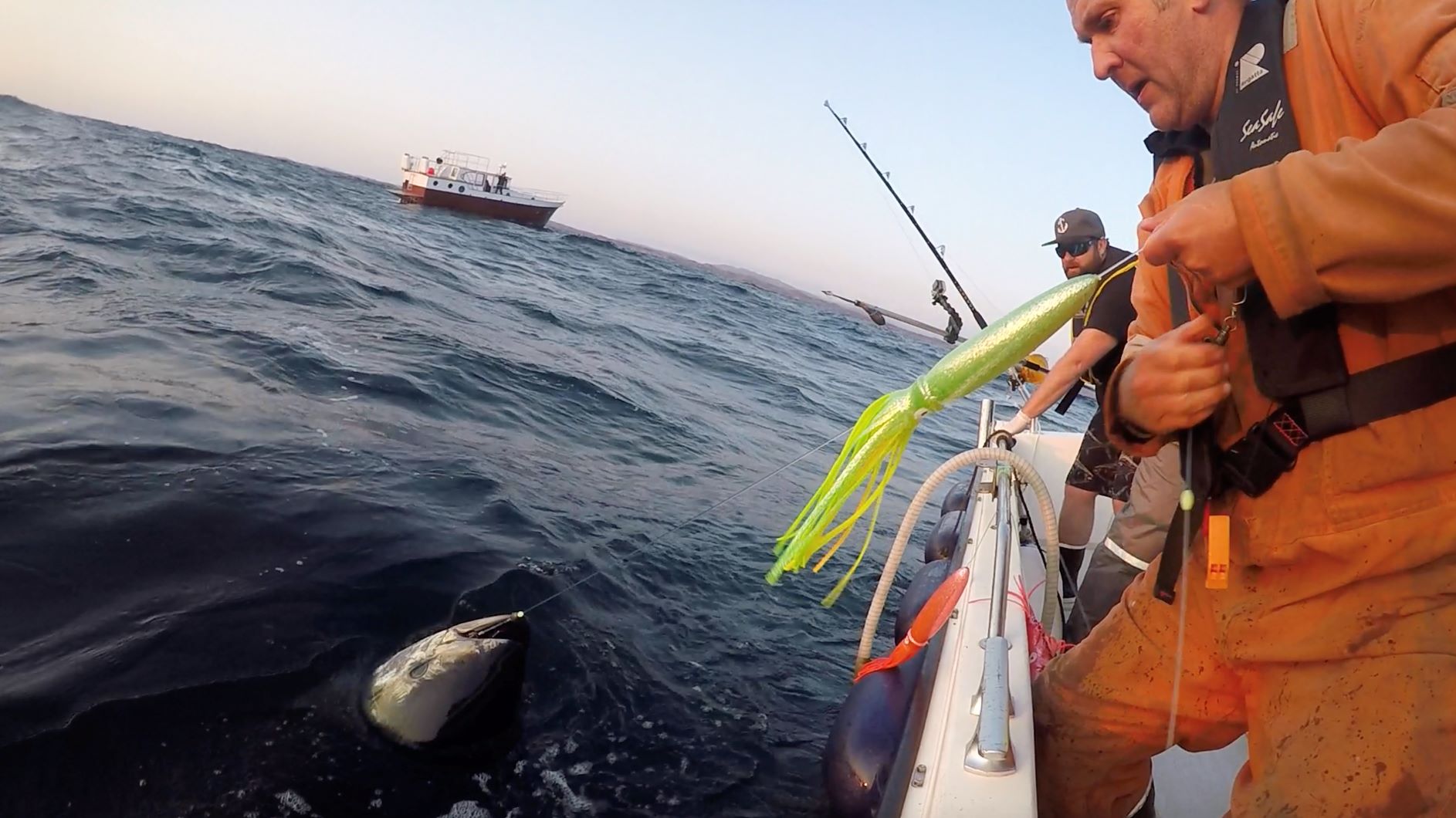Satellite tagging 20 bluefin tuna: The search is on
Team 9 ved godt mot under fiske med agn. Frå venstre Bjørn Florø-Larsen, Asmund Aasheim, John Olav Florø-Larsen og Bjørn Stein.
Photo: Erlend A. Lorentzen / HavforskningsinstituttetProsjektleder Keno Ferter og merkeekspert Sean Tracey frå University of Tasmania bemannar HI sin merkebåt.
Photo: Erlend A. Lorentzen / HavforskningsinstituttetTeam 11 prøver seg på green-sticking (sjå faktaboks).
Photo: Erlend A. Lorentzen / HavforskningsinstituttetTeam 6 ved lagleiar Asgeir Alvestad var raske på posisjonen der størja var observert. Mange båtar på same plass dekker eit mindre område, men gir samtidig betre effekt av chumming (sjå faktaboks).
Photo: Erlend A. Lorentzen / HavforskningsinstituttetHI sin merkebåt skal vere raskt på plassen om nokon krokar ei makrellstørje.
Photo: Erlend A. Lorentzen / HavforskningsinstituttetPublished: 27.08.2018 Updated: 31.08.2018
This was the message sent by VHF radio after four hours of fishing on day one of the project. Immediately several fishing boats in Øygarden made an about turn and headed for the same place.
The boats are there to help the Institute of Marine Research (IMR) to put satellite tags on 20 bluefin tuna off western Norway. Scientists are responsible for the tagging, while around 70 carefully chosen anglers are catching these “Formula 1” fish that can weigh up to 400 kilos.
Catching bluefin tuna with a rod is the least harmful technique if you want to release them again.
(UPDATE: On the evening of the 31st of August, the first bluefin tuna was tagged in Norwegian waters. See bottom message.)
Data logger sends data back to base
“The pop-up tag releases from the bluefin tuna after 365 days. A data logger collects depth, temperature and light level data that is transmitted back to base via satellite”, explains project manager Keno Ferter.
“A complex calculation then provides us with unique data on the movements of individual bluefin tuna.
The world’s largest tuna is once again coming to Norway to feed in summer, after a long absence due to international overfishing and poor recruitment. The bluefin tuna population has recovered significantly since the International Commission for the Conservation of Atlantic Tunas (ICCAT) implemented strict new rules ten years ago.
ICCAT is providing the twenty satellite tags, while the IMR is responsible for getting them onto the fish. The tagged fish will not count towards the fishing quota, as the aim is to release the giants back into the sea unharmed. The project adds to the already significant contribution that Norway is making to research into this returning visitor.
Volunteer researchers are a win-win
Friday 24 August was the first day of fishing. Five teams of anglers from far and wide had travelled to the island municipality of Øygarden off Bergen. More will come later.
When they applied to take part, they had to document that they had the necessary fishing gear, experience and attitude. They are contributing on an entirely voluntary basis. The Norwegian Association of Hunters and Anglers (NJFF) is a partner in the project and is responsible for liaising with the anglers.
“This is a win-win situation. Normally it is illegal to catch bluefin tuna with a rod in Norway, but these anglers are allowed to do so for this research project. We are grateful that they have come such a long with their boats and fishing gear to contribute. Because we need their unique skills”, says Keno Ferter.
“I’ve had a lifelong dream of being able to fish for bluefin tuna. I’m so excited, but I’m also nervous”, said angler Asmund Aasheim just before the starting gun on Friday.
Half an hour of high drama to end a long weekend
To minimise harm, the big fish must be reeled in as quickly as possible. This requires really heavy duty fishing gear. For example, anglers were only invited to apply if they had a reel with half a kilometre of line on it.
Jarle Olsen had a close encounter with a big fish on Sunday.
Over the weekend, the first teams fished long and hard using several different techniques (see fact box). There were several observations of bluefin tuna both at the surface and by echo sounder. Team 11 was probably closest to success on Sunday. After a day of trolling, they informed the IMR’s tagging boat that they had a fish on the line.
After a half-hour struggle and a 300-metre hard run, the fish was unfortunately lost. This event gave an important morale boost to both the anglers and scientists as they continued their search in Øygarden.
Follow the project
We will be regularly uploading new photos from the fishing. You are free to use them non-commercially if credited properly (Name Surname / Institute of Marine Research) Go to the photo pool.
UPDATE: On the evening of the 31st of August, the first bluefin tuna was tagged in Norwegian waters. Here is the "captain's log":
- This day is historic!
- Fishing started at 7am.
- One boat was fishing today.
- At 6.28 pm, the tagging boat was hailed.
- At 8.35 pm, the first bluefin tuna in history was tagged with a satelite tag.
- The fish was 2,4 meters.
